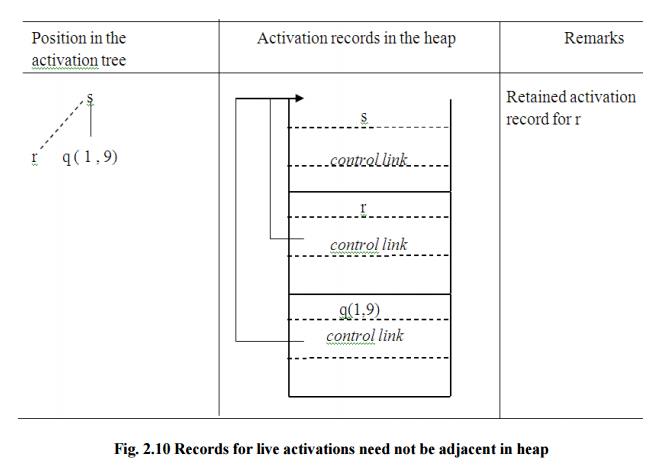Chapter: Principles of Compiler Design : Syntax Analysis and Run-Time Environments
Storage Allocation Strategies
STORAGE ALLOCATION STRATEGIES
The different storage allocation strategies are :
1. Static
allocation - lays out storage for all data objects at compile time
2. Stack
allocation - manages the run-time storage as a stack.
3. Heap
allocation - allocates and deallocates storage as needed at run time from a
data area known as heap.
STATIC ALLOCATION
In static allocation,
names are bound to storage as the program is compiled, so there is no need for
a run-time support package. Since the bindings do not change at run-time,
everytime a procedure is activated, its names are bound to the same storage
locations. Therefore values of local names are retained across activations of a
procedure.
That is, when control
returns to a procedure the values of the locals are the same as they were when
control left the last time. From the type of a name, the compiler decides the
amount of storage for the name and decides where the activation records go. At
compile time, we can fill in the addresses at which the target code can find
the data it operates on.
STACK ALLOCATION OF SPACE
All compilers for
languages that use procedures, functions or methods as units of user-defined
actions manage at least part of their run-time memory as a stack. Each time a
procedure is called , space for its local variables is pushed onto a stack, and
when the procedure terminates, that space is popped off the stack.
Calling sequences:
Procedures called are
implemented in what is called as calling sequence, which consists of code that
allocates an activation record on the stack and enters information into its
fields. A return sequence is similar to code to restore the state of machine so
the calling procedure can continue its execution after the call. The code in
calling sequence is often divided between the calling procedure (caller) and
the procedure it calls (callee).
When designing calling
sequences and the layout of activation records, the following principles are
helpful:
Ø
Values communicated between caller and
callee are generally placed at the beginning of the callee’s activation record,
so they are as close as possible to the caller’s activation record.
Fixed length items are generally
placed in the middle. Such i the control link, the accesslink, and the machine
status fields
Items
whose size may not be known early enough are placed at the end of the
activation
record.
The most common example is dynamically sized array, where the value of one of
the
callee’s parameters determines the length of the array.
We must locate the top-of-stack
pointer judiciously. A common approach is to have it pointto the end of
fixed-length fields in the activation record. Fixed-length data can then be
accessed by fixed offsets, known to the intermediate-code generator, relative
to the top-of-stack pointer.
The calling sequence and its division between caller
and callee are as follows:
Ø
The caller evaluates the actual parameters.
Ø
The caller stores a return address and
the old value of top_sp into the callee’s activation record. The caller then
increments the top_sp to the respective positions.
Ø
The callee saves the register values and
other status information.
Ø
The callee initializes its local data
and begins execution.
A suitable, corresponding return sequence is:
Ø
The callee places the return value next
to the parameters.
Ø
Using the information in the
machine-status field, the callee restores top_sp and other registers, and then
branches to the return address that the caller placed in the status field.
Ø
Although top_sp has been decremented,
the caller knows where the return value is, relative to the current value of
top_sp; the caller therefore may use that value.
Variable length data on stack:
The run-time memory
management system must deal frequently with the allocation of space for
objects, the sizes of which are not known at the compile time, but which are
local to a procedure and thus may be allocated on the stack. The reason to
prefer placing objects on the stack is that we avoid the expense of garbage
collecting their space. The same scheme works for objects of any type if they
are local to the procedure called and have a size that depends on the
parameters of the call.
HEAP ALLOCATION
Stack allocation strategy cannot be used if either
of the following is possible :
1.
The values of local names must be
retained when an activation ends.
2.
A called activation outlives the caller.
Heap allocation parcels
out pieces of contiguous storage, as needed for activation records or other
objects. Pieces may be deallocated in any order, so over the time the heap will
consist of alternate areas that are free and in use.

Fig.
2.10 Records for live activations need not be adjacent in heap
•
The record for an activation of
procedure r is retained when the activation ends.
•
Therefore, the record for the new
activation q(1 , 9) cannot follow that for s physically.
•
If the retained activation record for r
is deallocated, there will be free space in the heap between the activation
records for s and q.
Related Topics